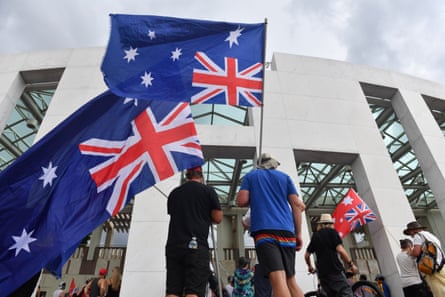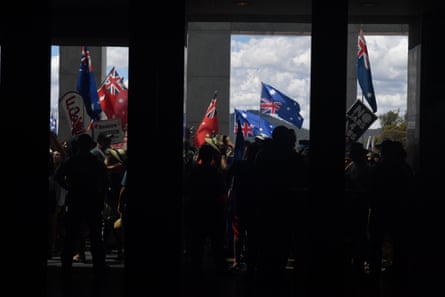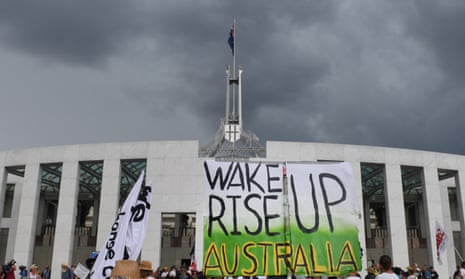Hundreds of protesters descended on Canberra this week in a noisy demonstration opposing vaccine mandates and to air a hodge-podge of other grievances.
In trucks and trailers, cars and campervans, the “Convoy to Canberra” lobbied in the nation’s capital on Monday, taking loud protests to Parliament House and the National Press Club. Hundreds have camped at unauthorised sites citywide; police moved in on Friday morning to dismantle a main site, but warn that protesters could be in town at least a week.
With an “Occupy Canberra” protest planned at Old Parliament House and federal parliament returning next week, experts on conspiracy movements are concerned the rallies may shift in tone.
The protesters are armed with a grab-bag of grievances around vaccinations, and seem to have equal disdain for all politicians. So who are they?
What are the Canberra protests?
It’s called the “Convoy to Canberra”, with participants in the protest driving en masse from as far away as north Queensland and Perth. Its roots snake to several recent events in the anti-vaccination and sovereign citizen space.

Inspired by large-scale truck driver protests in Canada, Australian anti-vaccine and anti-government groups began demanding a “trucker convoy for freedom” online. Dr Kaz Ross, a researcher who monitors conspiracy groups, said some involved in the convoy had links to January’s protests at old Parliament House, which saw the building’s doors damaged by fire.
Since launching in late January, a Facebook group grew to 172,000 followers, and a Telegram group to 30,000.
“End the mandates, end the restrictions, protect the children,” is one slogan from online posters.
But as groups ballooned, protesters expanded their list of grievances. By Tuesday, hundreds yelled claims that federal politicians were “paedophiles”, and called for prime minister Scott Morrison to be “removed”.
“There’s a few different strands coming together,” Dr Ross said.
“They say they’re sick of protesting and going home. That’s why they’re camping, they’re saying now is the time to ‘take back the government’.”
Who are the Canberra protesters?
“It’s a real hodge-podge,” said Elise Thomas, open source intelligence analyst with the Institute for Strategic Dialogue.
She said participants come from various backgrounds; anti-vaxxers, conspiracy theorists and people who lost jobs over vaccine mandates, but also parents and children, retirees, and “hippy” groups.
Protesters waved flags or wore merchandise supporting Donald Trump, the United Australia Party, One Nation, the dangerous QAnon conspiracy theory, and anti-lockdown groups. Cars were scrawled with slogans critical of Morrison, Victorian premier, Daniel Andrews, and NSW premier, Dominic Perrottet, while protesters outside Parliament House demanded Labor leader Anthony Albanese “come and face us”. Albanese was in Melbourne, not Canberra, at the time.

An event on the Parliament House lawns initially billed United Australia party leader Craig Kelly as a “special guest”, but Kelly did not speak at the event. Kelly MP did not return requests for comment, but he and other conservative MPs such as Gerard Rennick and George Christensen have voiced support for the anti-vaccine mandate protest movement.
“It’s hard to get a handle on who belongs to which group,” Thomas said.
“People might be in five different groups on Telegram. It’s a bit of a stew, it’s not super organised.”
Ross also noted the presence of “sovereign citizen” groups at police stations where supporters attempted to “serve papers” on public officials, in a bizarre push to have politicians arrested.
Morrison himself was “served” with papers at an Australia Day event, while standing with his family.
“They genuinely believe police will lay down arms and join them,” Ross said.
But at its roots, despite the diverse backgrounds, Ross said the protests come back to one common overarching theme.
“It’s vaccines. They try to cover up the anti-vax elements by saying it’s about freedom of choice, but the main motivator is the vaccine,” she said.
Protesters at the rallies counter this, claiming “we’re not anti-vax, we’re pro-choice”.
Why are they camping?
Simply, because many of them came from far away – and plan to stay. In makeshift campgrounds near the National Library, hundreds of cars, trucks and vans have been plonked in a public park, with number plates from Western Australia and Queensland.
They’re calling it “camp freedom”. Group leaders claimed it will “continue indefinitely” – but that was before dozens of police, some in riot gear, moved through the site on Friday morning to move on protesters and pack up tents.
Some slept in their cars, others in rollout swags or tents. It was an unauthorised camp area, and police had tried to move them on previously, leading to tense scenes on Wednesday night, as crowds advanced and several people were arrested.
It is expected that the Parliamentary Triangle will be the focus of protest activity for several days. Workers, visitors and people wishing to exercise in the area are advised to assess their need to be in the area. More: https://t.co/RZOW8FooVx pic.twitter.com/yz1JxWsinc
— ACT Policing (@ACTPolicing) February 2, 2022
“Police expect disruptions in the area to continue into next week,” ACT police said on Wednesday.
Ross said many protesters had spoken of losing jobs due to vaccine or lockdown issues. It means people have time to spare, and they’re joining a pop-up village; stereos loudly blare John Farnham classics, as people play games and cook communal breakfasts.
“It’s like holiday time for them,” Ross said.
“Something you see in those movements is people like being in a group, doing things together, and enjoying it as a social occasion.”
Thomas used the term “protest-ival”, likening the atmosphere to a festival.
“They get to talk to people who agree with them, which they might not get to usually do … That social element is a big appeal,” she said.
What happens next?
Since big protests on Monday and Tuesday, protesters have remained relatively quiet. They had settled into camp, but following the police move-on orders, they’ve been broken up and scattered through Canberra. Some headed to a large park in Canberra’s north to set up a new home base.
Many are encouraging more supporters to travel to Canberra this weekend, and expect their ranks to be swelled significantly.
Why? Because some protesters are planning a rally, branded “Operation Occupy Canberra”, at old Parliament House. Details are unclear, but Ross predicts “big numbers” of new supporters will arrive. Already, new contingents claim to be assembling in Queensland, to travel down in a new convoy.
Police declined to comment on how they’d respond on Saturday. Ross and Thomas were wary of making predictions, but voiced concerns about what could happen.
“There’s escalating rhetoric from some parts of the groups, that this is ‘their moment’,” Thomas said.
“They’re saying they want something to happen.”
